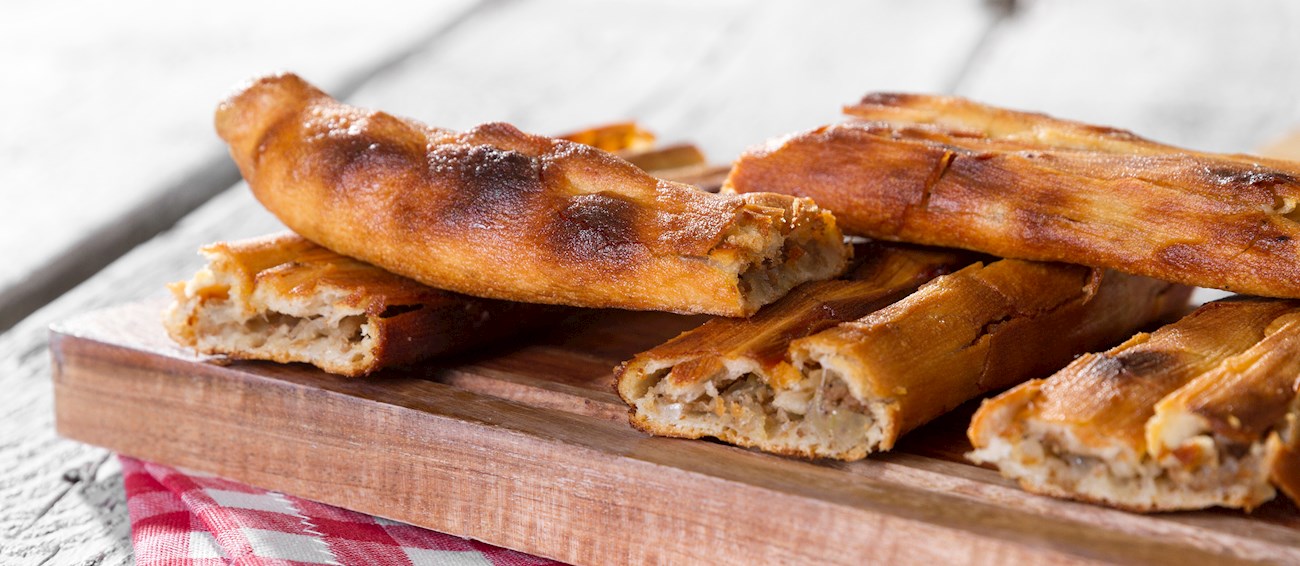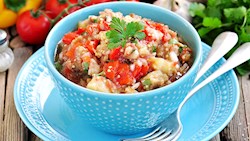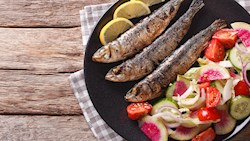Kahvaltı refers to breakfast in Turkish, and it's an essential and often lavish meal in Turkish culture. The word "kahvaltı" is derived from two words: "kahve" (coffee) and "altı" (under/before), which translates to "before coffee." It's a meal that traditionally happens before coffee is consumed, as in the Ottoman times, coffee was considered a beverage to be enjoyed after meals rather than during or before them.
Traditional Turkish kahvaltı showcases an expansive array of dishes, typically blending a multitude of flavors, textures, and food categories. The table is adorned with both sweet and savory items, spanning cheeses, olives, vegetables, local breads, eggs, börek, baklava or other sweet pastries, and more, accompanied by hot beverages such as Turkish tea (çay).
MAIN INGREDIENTS
Bafra pidesi, a traditional Turkish savory pie from Bafra, is known for its unique canoe shape and is about 1 meter (3.2 ft) long and 2.5 cm (1 inch) wide. The dough, made from flour, water, yeast, and salt, is rolled into an oval shape and filled with a mixture of medium-fat ground beef, which has been previously roasted and drained of fat, finely chopped onions, salt, and black pepper.
Once filled, it is sealed by pinching the ends together at the top and baked in a wood-fired oven (kara fırın) until browned. After baking, excess flour is brushed off, and the warm pita is opened and topped with small chunks of butter. It's then sliced into squares or baklava-like pieces for serving.
OTHER VARIATIONS OF Samsun Pidesi
MAIN INGREDIENTS
Turkish ice cream is believed to originate from the city of Maraş—hence the name—and what really sets it apart from other varieties is its resistance to melting and a particularly dense, chewy texture. These qualities are brought by adding two thickening agents to the basic milk and sugar mixture: Arab gum, also known as mastic resin, and salep—a type of flour made from the root of the early purple orchid.
In fact, in the Kahramanmaraş region, ice cream typically contains distinctly more salep than usual, which is why it is sometimes called kesme dondurma—from the Turkish kesmek, meaning to cut—which is the reason why this ice cream variety is usually eaten with a knife and fork.
MOST ICONIC Dondurma
View moreMAIN INGREDIENTS
Tombik döner or gobit kebab is a variety of döner kebab where the shredded meat is stuffed in a bun-shaped flatbread known as pide ekmek. The bread has a crispy exterior and a soft interior. This dish is typically served with additional ingredients, depending on the customer's choice, such as tomatoes, onions, lettuce, or other assorted vegetables and sauces.
OTHER VARIATIONS OF Kebab
MAIN INGREDIENTS
Antakya künefesi is a traditional kunāfah variety hailing from the ancient Turkish city of Antakya, made from shredded phyllo pastry filled with creamy unsalted cheese. The origins of this dish can be traced back to the Ottoman Empire, and to this day, it has remained one of the authentic representatives of Antakyan culinary heritage and traditions.
To make Antakya künefesi, the pastry is first prepared by shredding phyllo dough into thin strips and placing it into a flat, round tray. The dough, in this form known as kadayıfın, is then topped with a mixture of unsalted cheese, traditionally Hatay peyniri, and another layer of shredded phyllo dough.
OTHER VARIATIONS OF Kunāfah
MAIN INGREDIENTS
Manti are traditional Turkish dumplings filled with spiced ground meat and onions. The dumplings are most commonly topped with a sauce consisting of yogurt and garlic. The name of the dish is derived from mantu, meaning dumplings, and they were originally brought over from Central Asia to Türkiye by nomadic Turkish tribes in the 13th century.
Today, manti dumplings are popular throughout Turkey, as well as in numerous other cuisines such as Armenian, Afghan, and Central Asian.
VARIATIONS OF Manti
MOST ICONIC Manti
View moreMAIN INGREDIENTS
A type of sweet börek, katmer is a specialty of Gaziantep, or simply Antep – Türkiye's gastronomic capital and a rich melting pot of diverse cultures and cuisines nestled in southeastern Anatolia – an ancient city whose claim to fame is being home to world’s finest pistachios and the delicious Antep baklavası.
Katmer is what most locals start their day with: in fact, there are bakeries and cafés in Gaziantep open from early morning until noon serving katmer for breakfast. Traditionally, it is also the first meal eaten by newlyweds after their first wedding night, as it represents the sweetness they hope to find in their marriage.
OTHER VARIATIONS OF Börek
MOST ICONIC Katmer
View moreMAIN INGREDIENTS
Mercimek çorbası is a beloved Turkish soup made with red lentils, chicken stock, onions, and carrots. It is often seasoned with salt, pepper, cumin, or paprika. Easy to prepare, filling, and warming, the soup is consumed for breakfast, lunch, or dinner in rural parts of Turkey, especially in local eateries known as lokantas.
MOST ICONIC Mercimek çorbası
View moreHünkar beğendi is a traditional dish consisting of a flavorful lamb stew that is served on top of a creamy roasted eggplant purée. The purée is often thickened with milk and cheese, while the whole dish is sometimes topped with a tomato-based sauce or garnished with freshly chopped parsley.
It is believed that the dish is native to Istanbul and was first prepared for the wife of Napoleon III in the late 19th century.
MOST ICONIC Hünkar beğendi
View moreMAIN INGREDIENTS
The ancient Anatolian city of Antep, today known as Gaziantep, is Türkiye's gastronomic capital famous for being home to the world’s finest pistachios and the delicious Antep baklavası. Originally an Ottoman legacy, baklava is regarded as one of the greatest creations from the pastry chefs at Topkapı Sarayı, the major royal residence of Ottoman sultans from the 15th to the 19th century.
Baklava was traditionally prepared for Eid-al-Fitr, also known in Türkiye as Ramazan or Şeker Bayramı, a religious holiday when Muslims celebrate the ending of Ramadan, the Islamic holy month of fasting. Today, this Turkish treat is available year-round, and with more than 500 baklava bakeries in the city of Gaziantep, it is definitely not to be missed, especially during the pistachio harvest from midsummer to September, when these emerald-colored nuts are just the right size for baklava.
OTHER VARIATIONS OF Baklava
MOST ICONIC Gaziantep baklavası
View moreTasteAtlas food rankings are based on the ratings of the TasteAtlas audience, with a series of mechanisms that recognize real users and that ignore bot, nationalist or local patriotic ratings, and give additional value to the ratings of users that the system recognizes as knowledgeable. For the “Top 100 Turkish Foods” list until January 31, 2025, 40,053 ratings were recorded, of which 19,788 were recognized by the system as legitimate. TasteAtlas Rankings should not be seen as the final global conclusion about food. Their purpose is to promote excellent local foods, instill pride in traditional dishes, and arouse curiosity about dishes you haven’t tried.

































































































